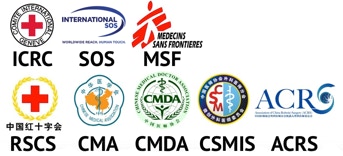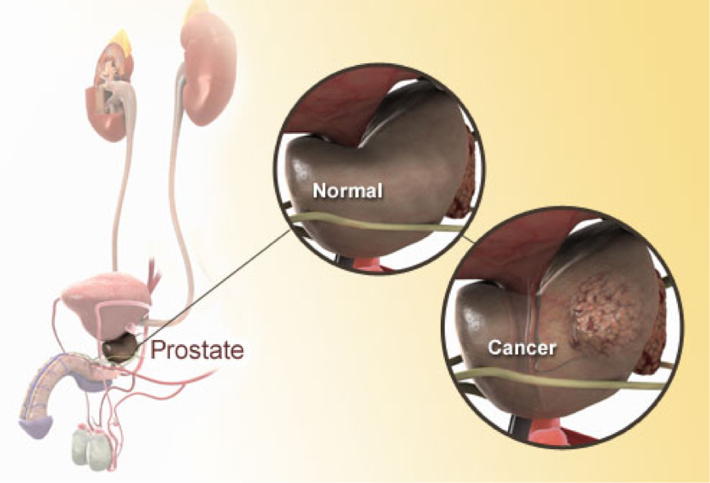

Doctors
Institutions
Conditions
Drugs
Insurances
TCM
Research
About Us
Contact Us
Prostate cancer is the abnormal growth of cells in a man's prostate gland . The prostate sits just below the bladder. It makes part of the fluid for semen. In young men, the prostate is about the size of a walnut. As men age, the prostate usually grows larger.
Prostate cancer is common in men older than 65. It usually grows slowly and can take years to grow large enough to cause any problems. As with other cancers, treatment for prostate cancer works best when the cancer is found early. Often, prostate cancer that has spread responds to treatment. Older men who have prostate cancer usually die from other causes. Experts don't know what causes prostate cancer, but they believe that your age, family history (genetics), and race affect your chances of getting it. What you eat, such as foods high in fats, may also play a part.
Prostate cancer usually doesn't cause symptoms in its early stages. Most men don't know they have it until it is found during a regular medical exam. When problems are noticed, they are most often problems with urinating. But these same symptoms can also be caused by an enlarged prostate (benign prostatic hyperplasia). An enlarged prostate is common in older men.
See your doctor for a checkup if:
You have urinary problems, such as:
Not being able to urinate at all.
Having a hard time starting or stopping the flow of urine.
Having to urinate often, especially at night.
Having pain or burning during urination.
You have difficulty having an erection.
You have blood in your urine or semen.
You have deep and frequent pain in your lower back, belly, hip, or pelvis.
The most common way to check for prostate cancer is to have a prostate-specific antigen (PSA) blood test. A higher level of PSA may mean that you have prostate cancer. But it could also mean that you have an enlargement or infection of the prostate.
If your PSA is high, you may need a prostate biopsy to figure out the cause. A biopsy means that your doctor takes tissue samples from your prostate gland and sends them to a lab for testing.
Your treatment will depend on what kind of cancer cells you have, how far they have spread, your age and general health, and your preferences. You and your doctor may decide to treat your cancer with surgery, radiation, hormone therapy, or a combination. Or if you have cancer that is low-risk and hasn't spread (early stage), you may be able to wait and watch with active surveillance to see what happens. During active surveillance, you will have regular checkups with your doctor to see if your cancer has changed.
Choosing treatment for prostate cancer can be confusing. Talk with your doctor to choose the treatment that's best for you. Your age and overall health will make a difference in how treatment may affect your quality of life. Any health problems you have before you are treated, especially urinary, bowel, or sexual function problems, will affect how you recover.
Both surgery and radiation can cause urinary incontinence (leaking urine) or impotence (not being able to have an erection). The level of urinary incontinence and how long it lasts and the quality of the erections a man has after treatment will depend on whether the cancer has spread. These also depend on what treatment is used.
Nerves that help a man have an erection are right next to the prostate. Surgery to remove the cancer may damage these nerves. Many times a special form of surgery, called nerve-sparing surgery, can preserve the nerves. But if the cancer has spread to the nerves, they may have to be removed during surgery. These same nerves can also be damaged by the X-rays that are used in radiation therapy.
Medicines and mechanical aids may help men who are impotent because of treatment. Some men recover part or most of their ability to have an erection several months or even years after surgery. Your treatment will depend on what kind of cancer cells you have, how far they have spread, your age and general health, and your preferences.
Like other forms of cancer, the prognosis for prostate cancer depends on how far the cancer has spread at the time it’s diagnosed. Doctors use a system of classification called staging to describe prostate cancer’s local extent and evidence of spread.
Prostate cancer stages can be complex and difficult to understand.
Prostate Cancer Stages: Growth and Spread
Prostate cancer grows locally within the prostate, often for many years. Eventually, prostate cancer extends outside the prostate. Prostate cancer can spread beyond the prostate in three ways:
By growing into neighboring tissues (invasion)
By spreading through the lymph system of lymph nodes and lymph vessels
By traveling to distant tissues through the blood (metastasis)
Prostate cancer stages describe the precise extent of prostate cancer’s spread.
Tests to Identify Prostate Cancer Stage
After a prostate cancer diagnosis, tests are done to detect how the cancer has spread, if it has, outside the prostate. Not all men need every test. It depends on the characteristics of a man’s prostate cancer seen on biopsy. Tests to help determine the stage of prostate cancer include:
Digital rectal exam
Prostate-specific antigen (blood test)
MRI of the prostate using a rectal probe
CT scan of the abdomen and pelvis, looking for prostate cancer metastasis to other organs
MRI of the skeleton, or a nuclear medicine bone scan, to look for metastasis to bones
Surgery to examine the lymph nodes in the pelvis for any prostate cancer spread
The TNM System for Prostate Cancer Stages
As they do for most cancers, doctors use the TNM system of prostate cancer stages. The prostate cancer stages are described using three different aspects of tumor growth and spread. It’s called the TNM system for tumor, nodes, and metastasis:
T -- for tumor -- describes the size of the main area of prostate cancer.
N -- for nodes -- describes whether prostate cancer has spread to any lymph nodes and to what extent.
M -- for metastasis -- means distant spread of prostate cancer, for example, to the bones or liver.
There are other ways of classifying prostate cancer, such as the Gleason system. Sometimes, the TNM system and Gleason score are combined together to describe prostate cancer stage.
Prostate Cancer Stage I
In stage I, prostate cancer is found in the prostate only and the PSA is <10. Stage I prostate cancer is microscopic, meaning it can’t be felt on a digital rectal exam (DRE) and it isn’t seen on imaging of the prostate. At most the tumor involves less than one-half of one lobe of the prostate.
Prostate Cancer Stage II
In stage II, the tumor has grown inside the prostate, but hasn’t extended beyond it. The tumor can involve more than one-half of one lobe of the prostate without involving both lobes (stage II-a). Or the tumor can involve both lobes (stage II-b).
Prostate Cancer Stage III
Stage III prostate cancer has spread outside the prostate, but only barely. Prostate cancer in stage III may involve nearby tissues, like the seminal vesicles. There is no spread to lymph nodes nor metastasis to distant tissue.
Prostate Cancer Stage IV
In stage IV, the cancer has spread (metastasized) outside the prostate to other tissues. Stage IV prostate cancer commonly spreads to lymph nodes, the bones, liver, or lungs.
Accurately identifying the prostate cancer stage is extremely important. Prostate cancer stage helps determine the optimal treatment, as well as prognosis. For this reason, it’s worth going through extensive testing to get the correct prostate cancer stage.
















